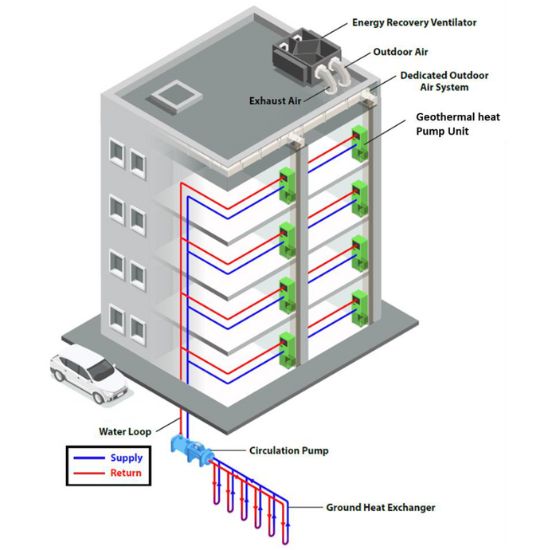Geothermal Heat Pumps Smooth Grid Operations
Oak Ridge National Laboratory’s technical analysis spotlights the practical grid impacts of geothermal heat pumps. Mass deployment can electrify U.S. buildings without overwhelming the electric power system.
According to an extensive technical analysis by Oak Ridge National Laboratory (ORNL), the nationwide deployment of geothermal heat pumps (GHPs) could create substantial benefits for the U.S. building sector, especially when paired with weatherization retrofits in single-family homes. The technology brings several advantages, from lower electricity costs and carbon dioxide (CO2) emissions to easing grid stress and transmission expansion.
A geothermal heat pump system under a house. Image used courtesy of ORNL
The study modeled a timeline from 2022 to 2050, where distributed GHPs replace conventional HVAC systems and combustion-based heating sources using gas, propane, and fuel oil. The researchers simulated GHP deployment across 68% of new and existing floor space in commercial and residential buildings. Three scenarios were applied:
- The base case of grid operation
- Decarbonization, targeting a 95% drop in emissions by 2035 and 100% clean electricity by 2050
- An expanded case with economy-wide electrification, including building heating
The models incorporated the impact of weatherization in single-family homes, which involves reducing outdoor ventilation and air-sealing leakage from HVAC ductwork, a common practice in heat pump retrofits.
In all scenarios, deploying 5 million GHPs annually resulted in substantial CO2 reductions through avoiding on-site fuel combustion. Emissions fell by 7,351 million metric tons (MMT), with 4,318 MMT stemming from a 26% decline in the building sector and 3,033 MMT from electric power.
Large-scale GHP deployment also saved $300 billion in electric grid services. GHPs reduce the overall cost of the power grid and the system cost of electricity, yielding even more savings by eliminating fuel consumption for space heating combustion.
Changes in building consumption and carbon emissions with GHP systems installed nationwide. Image used courtesy of ORNL (Figure ES-1, Page 16)
What Are Geothermal Heat Pumps?
GHPs are a well-established energy-efficiency technology. In the U.S., they’ve been in use since the 1940s when an Ohio scientist created the first ground-source heat pump for his home. About 50,000 GHPs are installed annually, according to the Department of Energy.
GHPs harness the earth’s relatively consistent geothermal temperatures, transferring heat in and out of the ground by circulating water through underground pipes. In cold regions where pipe-bursting is a concern, the water can be substituted with an antifreeze solution.
With high efficiency and fuel-free heating, GHPs reduce building energy costs and produce zero on-site emissions. They can also be used all year. In the winter, heat is drawn from the ground to warm buildings. In the summer, the ground serves as a heat sink.
Distributed GHP installations are usually coupled with a dedicated outdoor air system (DOAS) in a configuration separating external ventilation from the temperature control in each building zone.
A distributed GHP system paired with a DOAS. Image used courtesy of ORNL (Figure 3-1, Page 36)
While traditionally considered a building technology, the ORNL study argues that GHPs reduce costs and substantially cut CO2 emissions when paired with weatherization in single-family homes.
Technical Benefits of GHPs for Grid Operations
GHPs can strengthen the electric power system by alleviating generation and capacity needs.
ORNL’s analysis found about 593 TWh less generation was required annually for 2050 GHP deployment in the decarbonization scenario—close to the base scenario of 585 TWh. This was attributed to reductions in variable renewable energy outputs and hydrogen combustion turbines, with small increases in nuclear power. The electrification scenario needed 937 TWh less generation per year, seeing the same declines in hydrogen combustion turbines but with increased renewable reductions.
Annual electricity generation in 2050 across scenarios involving GHP and weatherization expansion. Image used courtesy of ORNL (Figure ES-2, Page 19)
GHP also eases the requirements for seasonal resource adequacy. The increase in heating electrified with GHP deployment is offset by electricity savings from high-efficiency GHP performance in summer cooling and reduced thermal loads from weatherization in single-family homes.
Using GHPs to replace natural gas furnaces and lessen electric heater consumption yields other benefits in grid operations. Some regions could cut peak demand up to 28%, avoiding the need to install more generation capacity. Since GHPs are more efficient than traditional air-conditioning systems, they can reduce loads with higher cooling demand in southern states. Likewise, GHPs can lower peak wintertime loads for most regions, including the southeast, which widely uses electric heating.
Easing Transmission Expansion
High-efficiency GHPs combined with weatherization, which reduces thermal loads, offer another advantage regarding transmission infrastructure. ORNL’s modeling found the need for transmission expansion falls by 33% under decarbonization and 37.6% under electrification, compared to 17% for the base scenario factoring GHP deployment.
In real terms, roughly 24,000 miles of transmission can be avoided in the decarbonization scenario and nearly double (43,500 miles) in the electrification scenario. These drops assume transmission lines have 1.5 GW of capacity.
Interregional transmission expansion with and without GHPs in the base and grid decarbonization scenarios. Image used courtesy of ORNL (Figure 4-3 and Table 4-1, Page 49)
Larger reductions are attributed to the longer transmission lines needed to link renewable resources to load centers, as well as the growing need for flexible power transfer over long distances.











